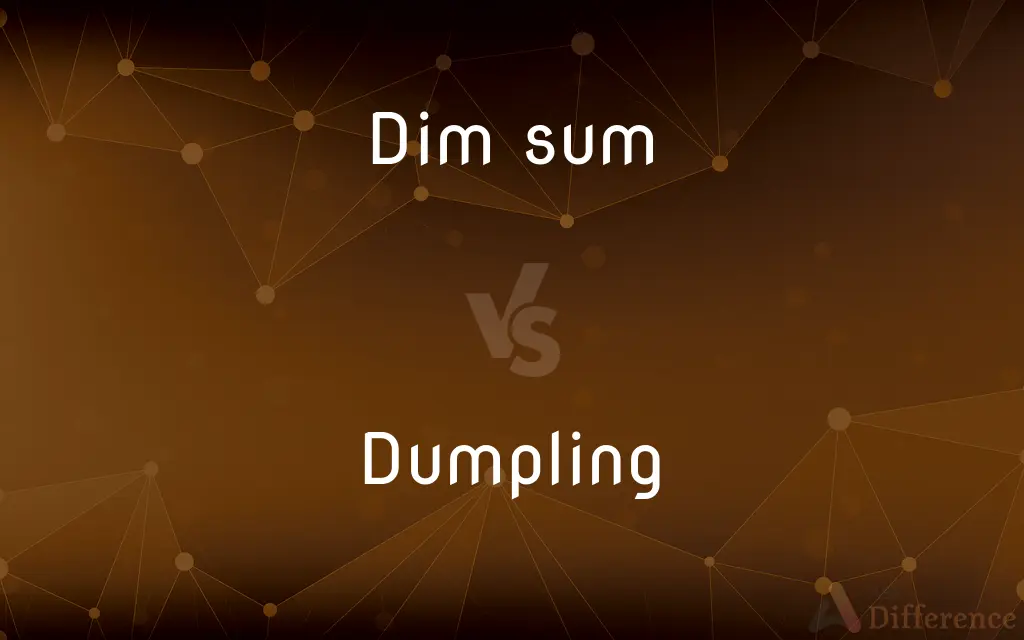Dim sum vs. Dumpling — What's the Difference?
By Urooj Arif & Maham Liaqat — Published on March 5, 2024
Dim sum refers to a variety of small Chinese dishes served with tea, including dumplings, while dumplings are a broad category of filled dough pockets found in many cuisines globally.

Difference Between Dim sum and Dumpling
Table of Contents
ADVERTISEMENT
Key Differences
Dim sum is a traditional Chinese cuisine that encompasses a wide range of small dishes, such as buns, pastries, and notably, dumplings. It is typically served during the late morning to early afternoon and is often accompanied by tea, making it a social dining experience known as "yum cha." Dim sum dishes are varied, featuring both sweet and savory flavors, and are steamed, fried, or baked.
Dumplings, on the other hand, are a specific type of food found in various forms across different cultures. They consist of pieces of dough, which can be made from bread, flour, or potatoes, wrapped around a filling. The filling can be meat, vegetables, or even sweets. Dumplings can be boiled, steamed, fried, or baked. In the context of dim sum, Chinese dumplings such as siu mai (shumai) and har gow are popular choices, but dumplings themselves transcend cultural and geographical boundaries, with each cuisine offering its unique version.
Dim sum represents a category of Chinese cuisine that includes a variety of dishes, whereas dumplings are a singular type of dish that can be part of dim sum or other meals. Dumplings are not limited to Chinese cuisine; they are a global phenomenon with variations like the Italian ravioli, Polish pierogi, and Japanese gyoza, demonstrating the versatility and universal appeal of filled dough.
The key difference lies in the scope: dim sum is a dining experience and a collection of dishes, of which dumplings are a part. In contrast, dumplings are a specific food item that can vary widely in preparation, ingredients, and serving methods, depending on the cultural context.
Comparison Chart
Origin
Chinese
Global
ADVERTISEMENT
Type
Variety of small dishes
Specific type of filled dough
Serving Time
Late morning to early afternoon
Any mealtime
Preparation
Steamed, fried, baked
Boiled, steamed, fried, baked
Accompaniment
Tea
Varied, depending on the cuisine
Varieties
Includes buns, pastries, dumplings
Meat, vegetables, sweets fillings
Cultural Significance
Part of "yum cha" tradition
Found in many cultures worldwide
Example Dishes
Siu mai, har gow, char siu bao
Ravioli, pierogi, gyoza, siu mai
Compare with Definitions
Dim sum
A variety of small Chinese dishes.
We ordered an assortment of dim sum, including steamed buns and dumplings.
Dumpling
Filled dough pockets.
Dumplings filled with pork and vegetables are a staple in many cuisines.
Dim sum
Social dining experience.
Families gather to enjoy dim sum during weekend brunches.
Dumpling
Boiled, steamed, or fried.
You can enjoy dumplings steamed, boiled, or pan-fried.
Dim sum
Served with tea.
Dim sum is traditionally enjoyed with tea in the late morning.
Dumpling
Global dish with variations.
From Italian ravioli to Japanese gyoza, dumplings appear in many cultures.
Dim sum
Encompasses dumplings.
Dim sum selections often feature popular dumplings like har gow.
Dumpling
Can be savory or sweet.
Dumplings may contain meat, vegetables, or even fruit fillings.
Dim sum
Involves multiple cooking methods.
Dim sum dishes can be steamed, fried, or baked to perfection.
Dumpling
Part of dim sum and other meals.
While dumplings are a key part of dim sum, they're also enjoyed in various other settings.
Dumpling
A piece of dough, sometimes filled, that is cooked in liquid such as water or soup.
Dumpling
Sweetened dough wrapped around fruit, such as an apple, baked and served as a dessert.
Dumpling
(culinary) A ball of dough that is cooked and may have a filling and/or additional ingredients in the dough.
Dumpling
By restriction, a food composed of a dough wrapper around a filling.
Dumpling
A roundish mass of dough boiled in soup, or as a sort of pudding; often, a cover of paste inclosing an apple or other fruit, and boiled or baked; as, an apple dumpling.
Common Curiosities
Can dumplings be considered a meal?
Yes, dumplings can be considered a meal on their own, especially when served in sufficient quantities and accompanied by side dishes or a broth.
Are all dumplings part of dim sum?
Not all dumplings are part of dim sum. While many Chinese dumplings are featured in dim sum, dumplings from other cuisines are not traditionally served in this context.
What makes dim sum unique?
Dim sum is unique for its wide variety of small dishes and the social experience of sharing these dishes among friends and family, often accompanied by tea.
How do I know if a dumpling is Chinese or from another cuisine?
The ingredients, cooking method, and sometimes the shape can indicate a dumpling's origin. Familiarizing yourself with different dumplings from various cuisines can also help.
How important is tea to the dim sum experience?
Tea is an integral part of the dim sum experience, aiding in digestion and enhancing the social aspect of sharing a meal.
Can dim sum include dishes other than dumplings?
Absolutely, dim sum encompasses a wide range of dishes including steamed buns, rice noodle rolls, and tarts, in addition to dumplings.
What is the best way to enjoy dim sum?
The best way to enjoy dim sum is with a group, allowing you to try a variety of dishes, and traditionally, with tea to complement the meal.
Can I make dumplings or dim sum at home?
Yes, both dumplings and various dim sum dishes can be made at home with the right ingredients and recipes, though some might require practice to master.
Do dumplings always have to be savory?
No, dumplings can also be sweet, filled with ingredients like fruit or sweet bean paste, and served as desserts or snacks.
Is dim sum only served for breakfast?
While traditionally enjoyed in the late morning, dim sum can be served into the early afternoon, making it suitable for brunch or lunch.
Are there vegetarian options in dim sum and dumplings?
Yes, there are numerous vegetarian options available in both dim sum and dumplings, featuring vegetable or tofu fillings.
What is the origin of dim sum?
Dim sum originated from the Cantonese regions of China and has a history linked to the tradition of "yum cha" or drinking tea, evolving into a meal with various small dishes.
Are there health considerations when eating dim sum or dumplings?
Yes, both can range from healthy to high-calorie options depending on the ingredients and cooking methods. Steamed dim sum and vegetable-filled dumplings can be healthier choices.
Is it possible to find gluten-free dumplings or dim sum?
Yes, though traditional recipes include gluten, many places now offer gluten-free options by using alternative flours for the dough and fillings that cater to dietary restrictions.
How do dim sum chefs train for their craft?
Dim sum chefs often undergo extensive training in the art of Chinese cuisine, with a specific focus on mastering the delicate balance of flavors, dough preparation, and intricate cooking techniques required for dim sum.
What is the significance of tea in dim sum culture?
Tea plays a critical role in dim sum culture, aiding digestion, enhancing flavors, and facilitating social interaction. It's a tradition rooted in the ancient Chinese practice of "yum cha."
How do I choose between dim sum and dumplings if I'm new to both?
If you're interested in a wide variety of tastes and a communal dining experience, opt for dim sum. Choose dumplings if you prefer focusing on exploring the diverse fillings and preparation methods of this specific dish.
Share Your Discovery

Previous Comparison
iCloud vs. iTunes
Next Comparison
3G vs. LTEAuthor Spotlight
Written by
Urooj ArifUrooj is a skilled content writer at Ask Difference, known for her exceptional ability to simplify complex topics into engaging and informative content. With a passion for research and a flair for clear, concise writing, she consistently delivers articles that resonate with our diverse audience.
Co-written by
Maham Liaqat















































